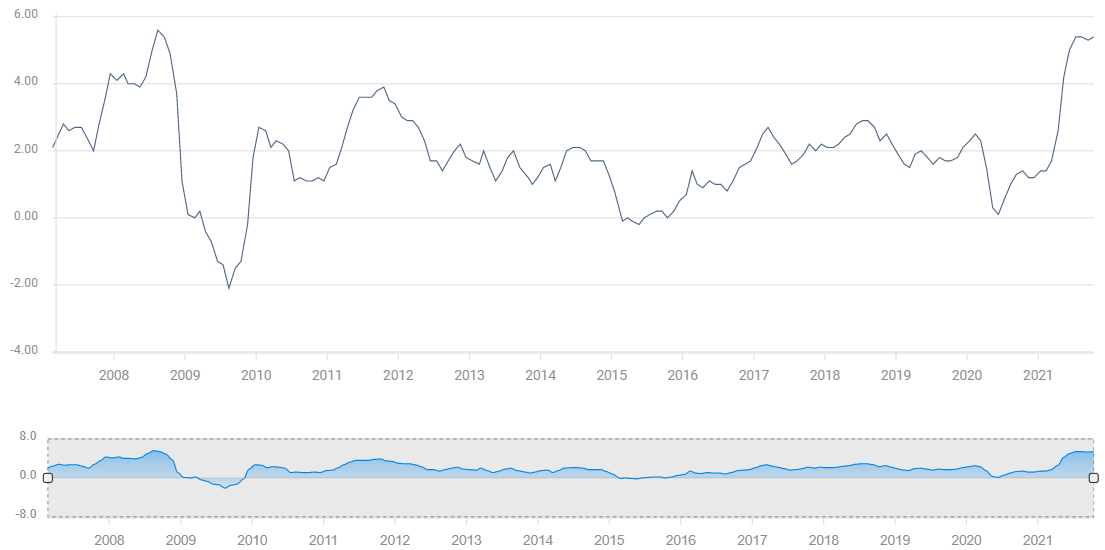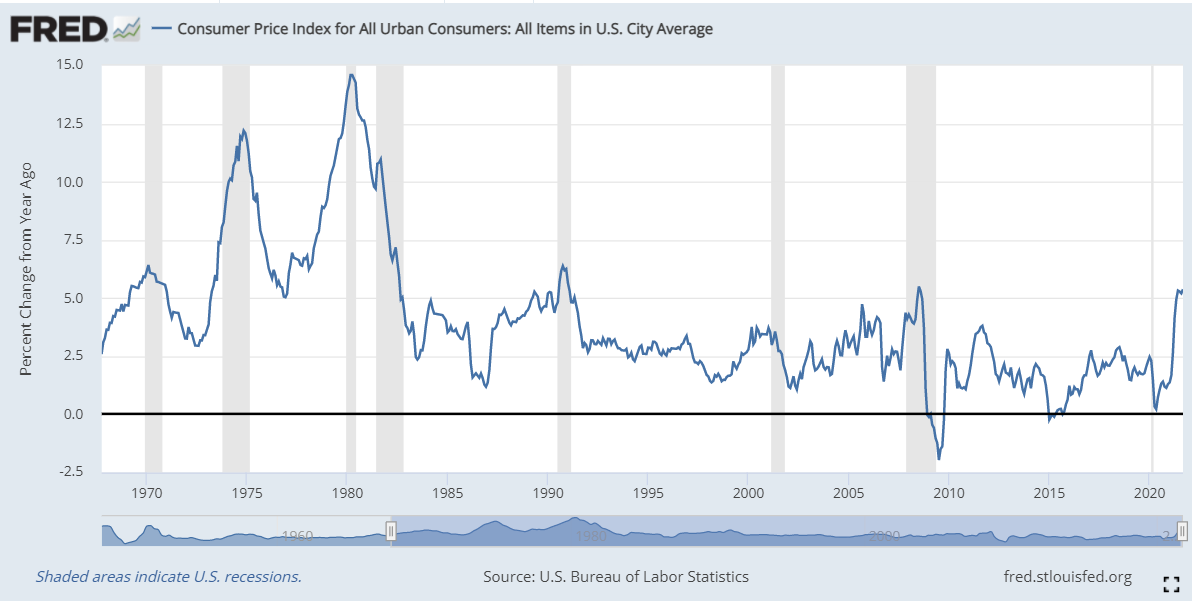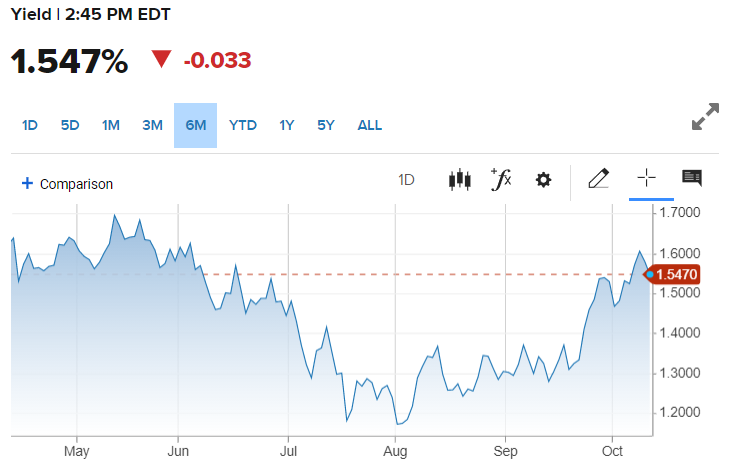- Consumer inflation rises 0.4% in September to 5.4% annually, highest in 13 years.
- Food and gasoline climb 1.2% on the month, 4.5% and 42.1% on the year.
- Core CPI gains 0.2%, as forecast, to 4% yearly.
- St. Louis Fed President Bullard says Fed should be more aggressive in tapering.
Food and gasoline were the driving facts in US consumer inflation last month, pushing the price index to its highest annual increase in 13 years while the core rate remained stable.
The Consumer Price Index (CPI) rose 0.4% last month after a 0.3% gain in August, reported the Labor Department Wednesday. A 0.3% increase had been predicted by analysts.
CPI
Over the last year prices climbed 5.4%, slightly ahead of the 5.3% forecast. It was the largest 12-month increase since July 2008 and the second highest in three decades
CPI
Core CPI, excluding food and energy prices, rose 0.2% in September up from 0.1% in August and was unchanged at 4% for the year.
CPI details
Food prices climbed 1.2% for the month after a 0.4% increase in August and were 4.5% higher on the year. Meat expenses were up 3.3% in September and 12.6% annually.
Gasoline prices rose 1.2% last month following a 2.8% increase in August and a 2.4% gain in July, bringing the annual surge to 42.1%. Fuel oil, which heats many older homes, jumped 3.9% in September and is 42.6% more costly on the year.
Shelter expenses added 0.4% for the month and 3.2% for the year. The homeowners rental equivalent rose 0.4% in September, its biggest monthly increase since June 2006.
Several categories of consumer goods saw losses, underlining the intensity of the generalized increase in the economy, despite sector declines..
Used car prices, which had received much attention recently, dropped 0.7% for the month, lowering the 12-month gain to 24.4%. With new cars in short supply due to component and computer chip shortages, prices rose another 1.3% in September, leaving the annual increase at 8.7%.
Airline fares fell 6.4% in September.
Clothing prices slipped 1.1% in September while transport costs fell 0.5%. Nevertheless, purchase costs in both sectors were higher on the year, 3.4% and 4.4% respectively.
Market response
With consumer prices for September largely as anticipated, and having avoided a feared acceleration, Treasury yields retreated from their sharp increases of the past three weeks.
The 10-year yield had fallen 3 basis points to 1.547% by the early afternoon. The 30-year shed 6 points to 2.04%.
10-year Treasury yield
CNBC
Equites were flat with the Dow falling mere points and the S&P 500 rising about 0.10%.
The dollar lost ground against all the majors but retained most of its recent gains.
Federal Reserve
Markets have been anticipating that the Federal Reserve’s long-bruited taper of its $120 billion a month in bond purchases will be announced at the November 3 meeting
St. Louis Fed President James Bullard said in a Tuesday interview on CNBC that he supports starting the taper process in November and that the bank should be more aggressive in withdrawing economic support.
Also on Tuesday, Atlanta Fed President Raphael Bostic said the causes of the current inflation “will not be brief.”
These comments were backed up by the minutes of the last Federal Open Market Committee (FOMC) released at 2 pm which elaborated on the September statement, “If progress continues broadly as expected, the Committee judges that a moderation in the pace of asset purchases may soon be warranted.”
Conclusion
The September CPI numbers have not moved the discussion of the prospective Fed taper in either direction.
Consumer inflation is at its highest level in a generation and the factors driving the price gains, particularly wages and energy costs, are proving to be far more than transitory.
Labor, component and raw material shortages, shipping delays and consumer demand are all conspiring to drive prices to their highest sustained increases since the1980s.
The Fed’s anticipated November 3 taper strike remains on track.
Information on these pages contains forward-looking statements that involve risks and uncertainties. Markets and instruments profiled on this page are for informational purposes only and should not in any way come across as a recommendation to buy or sell in these assets. You should do your own thorough research before making any investment decisions. FXStreet does not in any way guarantee that this information is free from mistakes, errors, or material misstatements. It also does not guarantee that this information is of a timely nature. Investing in Open Markets involves a great deal of risk, including the loss of all or a portion of your investment, as well as emotional distress. All risks, losses and costs associated with investing, including total loss of principal, are your responsibility. The views and opinions expressed in this article are those of the authors and do not necessarily reflect the official policy or position of FXStreet nor its advertisers. The author will not be held responsible for information that is found at the end of links posted on this page.
If not otherwise explicitly mentioned in the body of the article, at the time of writing, the author has no position in any stock mentioned in this article and no business relationship with any company mentioned. The author has not received compensation for writing this article, other than from FXStreet.
FXStreet and the author do not provide personalized recommendations. The author makes no representations as to the accuracy, completeness, or suitability of this information. FXStreet and the author will not be liable for any errors, omissions or any losses, injuries or damages arising from this information and its display or use. Errors and omissions excepted.
The author and FXStreet are not registered investment advisors and nothing in this article is intended to be investment advice.
Recommended Content
Editors’ Picks

EUR/USD treads water just above 1.0400 post-US data
Another sign of the good health of the US economy came in response to firm flash US Manufacturing and Services PMIs, which in turn reinforced further the already strong performance of the US Dollar, relegating EUR/USD to the 1.0400 neighbourhood on Friday.

GBP/USD remains depressed near 1.2520 on stronger Dollar
Poor results from the UK docket kept the British pound on the back foot on Thursday, hovering around the low-1.2500s in a context of generalized weakness in the risk-linked galaxy vs. another outstanding day in the Greenback.

Gold keeps the bid bias unchanged near $2,700
Persistent safe haven demand continues to prop up the march north in Gold prices so far on Friday, hitting new two-week tops past the key $2,700 mark per troy ounce despite extra strength in the Greenback and mixed US yields.

Geopolitics back on the radar
Rising tensions between Russia and Ukraine caused renewed unease in the markets this week. Putin signed an amendment to Russian nuclear doctrine, which allows Russia to use nuclear weapons for retaliating against strikes carried out with conventional weapons.

Eurozone PMI sounds the alarm about growth once more
The composite PMI dropped from 50 to 48.1, once more stressing growth concerns for the eurozone. Hard data has actually come in better than expected recently – so ahead of the December meeting, the ECB has to figure out whether this is the PMI crying wolf or whether it should take this signal seriously. We think it’s the latter.

Best Forex Brokers with Low Spreads
VERIFIED Low spreads are crucial for reducing trading costs. Explore top Forex brokers offering competitive spreads and high leverage. Compare options for EUR/USD, GBP/USD, USD/JPY, and Gold.


